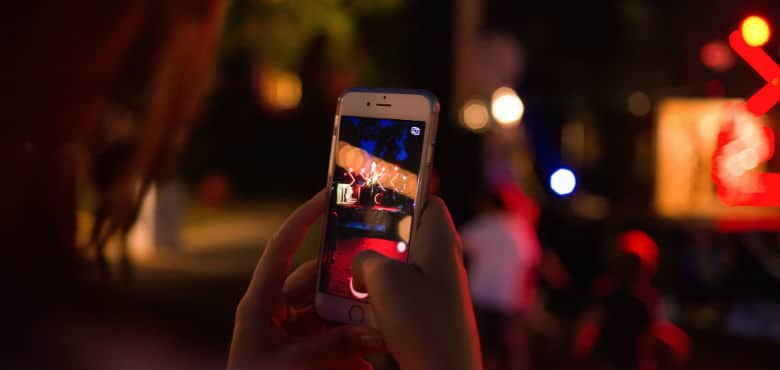Mobile phones being used as CCTV
Most Australians are now equipped with smartphones, with almost 17 million of the devices currently in use throughout the country—all of which are capable of streaming and recording video which can be used for CCTV purposes.
This means the way that security systems are being installed, monitored and used is changing, with mobile devices playing a key role in that transformation. So how exactly are smartphones are driving this revolution?
How mobile phones are being used as DIY CCTV
As mobile phone technology continues to improve, people have been able to construct their own CCTV security systems using the devices.
There are literally hundreds of CCTV apps available on the market—including the likes of VHDR, iCamViewer, Security Cam, XProtect Mobile and Smartvue.
Among these options is Manything—an app that makes it possible to set up an old unused phone as a security camera, using your current primary device as the control and viewing centre for all operations.
Additionally, smartphones are also able to control many security camera models, and provide live surveillance streams for users on the go. Kits like GetSafe Home Security, Vivint Smart Home and ADT Pulse are just some of the setups that allow people to monitor and control their cameras using their personal devices.
There is a key point to the DIY approach however: it not as easy to install or operate as one might think. Due to the high volume of apps available, users have to adopt a trial-and-error approach to see which works best—if at all—with their device(s). More notably, many contain hidden fees, while others are buggy with certain devices, and some apps work brilliantly in the short-term, but are prone to crashing in the future.
This means that the DIY approach may be cheap, but it is far from the most reliable option in the realm of security.
How the security industry can use smartphone technology
The advent of the Internet of Things is seeing more and more connected devices in the average home. Electricity providers are providing apps that allow users to control thermostats, lighting and other electrical devices remotely. Internet-connected devices like Google Home is also giving customers smarter ways to gather information and control technology in their home. These advancements have extended to home security, with security installers and providers already rolling out solutions that tap into these IoT innovations.
One Australian innovation is the CleverLoop, which includes an internet-connected hub that acts as the base station for the entire operation. It connects to security cameras to feed the stream to mobile devices, alerting the end-user. This solution allows businesses to view the live footage on their own devices.
Jim’s Security is another domestic company applying a smart home approach, networking its CCTV systems with mobile devices to allow for remote monitoring by both the security company and the client. Both of these companies use their own software, apps and monitoring services to use the internet as a security tool.
The elimination of landlines for alarm systems
Until recently, security systems would require a hard-wired telephone system to send distress signals to relevant organisations and authorities. That created an obvious weak point, where this line could be deliberately damaged or severed.
Modern security systems are able to use mobile phone networks to send these signals, as well as ensuring everything is working as it should. To ensure the system is functioning correctly, security systems can send small packets of information at regular intervals through the mobile network to a monitoring centre. If this signal is lost, then something has gone wrong.
This has led to mobile providers entering the security industry, including big players like Telstra. The telco has rolled out Home Protect, a setup that connects a home security system through the Telstra mobile network to a secure monitoring centre. This allows people to have a 24/7 back-to-base alarm monitoring service that is provided and monitored by their mobile phone and internet provider.
How authorities are using mobile phone footage in the fight against crime
Mobile phones themselves are being used as tools by authorities to uncover valuable information where CCTV footage falls short. CCTV cameras cannot be everywhere, but mobile phones cast a wide lens for authorities to tap into.
Deloitte’s Mobile Consumer Survey 2016 revealed that 84 per cent of Australians had access to a smartphone, a rise from 79 per cent in 2015. This gives authorities more eyes on crime scenes than ever before, if they use it well enough.
A recent example of this was the 2016 disaster at Gold Coast theme park Dreamworld where four people died when a ride malfunctioned. In the consequent investigations, CCTV cameras inside of the park could not tell the story of how it happened. That prompted Queensland Police to issue a call to the public for any vision on their phones which could help in their investigations.
“With Dreamworld being so popular, we know there was a significant number of people here and we want to appeal for anyone that may have information to come forward,” Detective Inspector Mark Thompson said at the time.
The investigation is ongoing and a public inquest is due to be held in 2018.
Looking towards the future
Smartphones have a critical role to play in security and the installation, monitoring and access to systems in homes and businesses in the future. While DIY setups may be somewhat unreliable, mobile devices reach corners that current CCTV cameras can’t. They can also provide a remote access point to camera streams, eliminating the need for control rooms.
This technology is only going to advance further. As a result, security installers and managers will need to fully grasp an understanding of the role mobile phones will play. Ultimately, this presents a valuable upskilling opportunity for professionals throughout the industry.
For more articles like this, subscribe to the Security Newsletter
You may also like
-
Stay up to date with the latest news and Security updates.
- Subscribe

